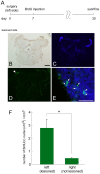Spontaneous recovery of the injured higher olfactory center in the terrestrial slug limax
- PMID: 20161701
- PMCID: PMC2816995
- DOI: 10.1371/journal.pone.0009054
Spontaneous recovery of the injured higher olfactory center in the terrestrial slug limax
Abstract
Background: Of all organs and tissues in adult mammals, the brain shows the most limited regeneration and recovery after injury. This is one reason why treating neurological damage such as ischemic injury after stroke presents such a challenge. Here we report a novel mode of regeneration which the slug's cognitive center, the procerebrum, shows after surgical lesioning in the adult. It is well known that the land slug Limax possesses the capacity to demonstrate conditioned food aversion. This learning ability critically depends on the procerebrum, which is the higher olfactory center in the brain of the terrestrial mollusk.
Principal findings: In the present study, after a 1-month recovery period post-surgical lesioning of the procerebrum we investigated whether the brain of the slug shows recovery from damage. We found that learning ability, local field potential oscillation, and the number of cells in the procerebrum (PC) all recovered spontaneously within 1 month of bilateral lesioning of the PC. Moreover, neurogenesis was enhanced in the lesioned PC. However, memory acquired before the surgery could not be retrieved 1 month after surgery although the procerebrum had recovered from injury by this time, consistent with the notion that the procerebrum is the storage site of odor-aversion memory, or deeply involved in the memory recall process.
Significance: Our findings are the first to demonstrate that a brain region responsible for the associative memory of an adult organism can spontaneously reconstitute itself, and can recover its function following injury.
Conflict of interest statement
Figures







Similar articles
-
Glutamatergic neurotransmission in the procerebrum (olfactory center) of a terrestrial mollusk.J Neurosci Res. 2009 Oct;87(13):3011-23. doi: 10.1002/jnr.22130. J Neurosci Res. 2009. PMID: 19472222
-
Spontaneous regeneration of the central nervous system in gastropods.Biol Bull. 2011 Aug;221(1):35-42. doi: 10.1086/BBLv221n1p35. Biol Bull. 2011. PMID: 21876109 Review.
-
Recovery of learning ability after the ablation of the procerebrum in the terrestrial slug, Limax valentianus.Acta Biol Hung. 2008;59 Suppl:73-6. doi: 10.1556/ABiol.59.2008.Suppl.11. Acta Biol Hung. 2008. PMID: 18652375
-
Olfactory Memory Storage and/or Retrieval Requires the Presence of the Exact Tentacle Used During Memory Acquisition in the Terrestrial Slug Limax.Zoolog Sci. 2016 Feb;33(1):78-82. doi: 10.2108/zs150128. Zoolog Sci. 2016. PMID: 26853872
-
Oscillations and gaseous oxides in invertebrate olfaction.J Neurobiol. 1996 May;30(1):110-22. doi: 10.1002/(SICI)1097-4695(199605)30:1<110::AID-NEU10>3.0.CO;2-Q. J Neurobiol. 1996. PMID: 8727987 Review.
Cited by
-
DNA endoreplication in the brain neurons during body growth of an adult slug.J Neurosci. 2011 Apr 13;31(15):5596-604. doi: 10.1523/JNEUROSCI.0179-11.2011. J Neurosci. 2011. PMID: 21490200 Free PMC article.
-
Regulation and restoration of motoneuronal synaptic transmission during neuromuscular regeneration in the pulmonate snail Helisoma trivolvis.Biol Bull. 2011 Aug;221(1):110-25. doi: 10.1086/BBLv221n1p110. Biol Bull. 2011. PMID: 21876114 Free PMC article.
-
Distribution and physiological effect of enterin neuropeptides in the olfactory centers of the terrestrial slug Limax.J Comp Physiol A Neuroethol Sens Neural Behav Physiol. 2020 May;206(3):401-418. doi: 10.1007/s00359-020-01400-2. Epub 2020 Jan 29. J Comp Physiol A Neuroethol Sens Neural Behav Physiol. 2020. PMID: 31996989
References
-
- Gage FH. Mammalian neural stem cells. Science. 2000;287:1433–1438. - PubMed
-
- Moffett SB. Neural regeneration in gastropod molluscs. Prog Neurobiol. 1995;46:289–330. - PubMed
-
- Snyder KA, Moffett SB. Locomotion in the pulmonate snail Melampus–II. Recovery after pedal ganglion excision. Comp Biochem Physiol A Comp Physiol. 1990;96:407–414. - PubMed
-
- Eakin R, Ferlatte MM. Studies on eye regeneration in a snail, Helix aspersa. J Exp Zool. 1973;184:81–96. - PubMed
-
- Chase R, Kamil R. Morphology and odor sensitivity of regenerated snail tentacles. J Neurobiol. 1983;14:43–50. - PubMed
Publication types
MeSH terms
Substances
LinkOut - more resources
Full Text Sources
Research Materials

